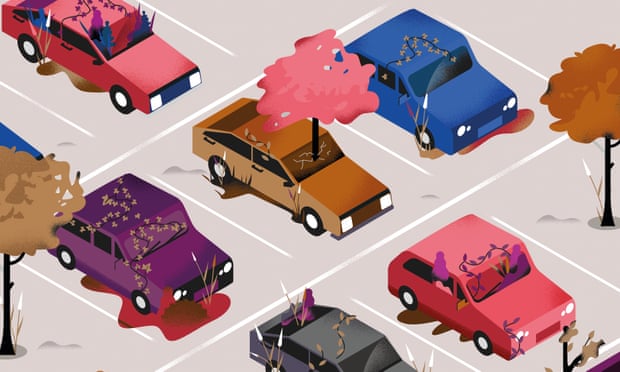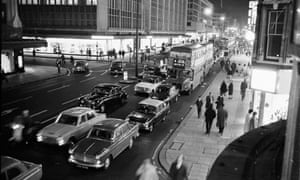
If ours is an age in which no end of institutions and conventions are being disrupted, it shouldn’t come as a surprise that one of the most basic features of everyday life seems under serious threat. If you are fortunate enough to live in a house with a drive, look outside and you will probably see it: that four-wheeled metal box, which may well be equipped with every technological innovation imaginable, but now shows distinct signs of obsolescence.
To put it another way: after a century in which the car has sat at the heart of industrial civilisation, the age of the automobile – of mass vehicle ownership, and the idea (in the western world at least) that life is not complete without your own set of wheels – looks to be drawing to a close. Top Gear is a dead duck. No one writes pop songs about Ferraris any more. The stereotypical boy racer appears a hopeless throwback. And in our cities, the use of cars is being overtaken by altogether greener, more liberating possibilities.
The sale of diesel and petrol cars is to be outlawed in the UK from 2040. But only 10 days ago Oxford announced that it is set to be the first British city to ban all petrol and diesel cars and vans – from a handful of central streets by 2020, extending to the entire urban centre 1o years later. Paris will ban all non-electric cars by 2030, and is now in the habit of announcing car-free days on which drivers have to stay out of its historic heart. In the French city of Lyon, car numbers have fallen by 20% since 2005, and the authorities have their sights set on another drop of the same magnitude. London, meanwhile, has shredded the idea that rising prosperity always triggers rising car use, and seen a 25% fall in the share of journeys made by car since 1990.
Last week, highlighting the increasingly likely arrival of driverless vehicles, General Motors announced that it will soon begin testing autonomous cars in the challenging conditions of New York City, apparently the latest step in the company’s rapid and handsomely funded move towards building a new fleet of self-driving taxis. Earlier this year, forecasters at Bank of America tentatively claimed that the US may have reached “peak car”, acknowledging that “transportation is costly and inefficient, making the sector ripe for disruption”. Their focus was on ride-sharing services, car-pool apps and the collective use of bikes: what they were predicting had the sense of a reality that is already plain to see.
There are caveats to all this, of course. Although cities in the world’s rising economies are just as fond of car-sharing and bike use as anywhere in the west, car ownership in India and China is rising vertiginously. And as one of the 25,000 residents of a West Country town that is expanding fast and now prone to gridlock, I can confirm that in swaths of this country, the idea that we will soon surrender our vehicles can easily look rather far-fetched. The recent farcical launch by Great Western Railway of its new intercity trains (plagued by technical problems, and now taken out of service) highlights how our public transport remains woeful. Even if it brings regular twinges of guilt, there is currently little alternative to owning a car, and using it every day.
But deep social trends do point in another direction. In 1994 48% of 17- to 20-year-olds and 75% of 21- to 29-year-olds had driving licences. According to the National Travel Survey, by 2016 these figures had dropped respectively to 31% and 66%. Some of this, of course, is down to the deep financial insecurities experienced by millennials, and the stupid costs of car insurance. But in the context of technological change, it looks like it might have just as much to do with the likely shape of the future. If you buy most of your stuff online, the need to drive to a supermarket or shopping centre dwindles to nothing; if you are in daily touch with distant friends and family online, might a time-consuming visit to see them feel that bit less urgent? Meanwhile, at the other end of the demographic spectrum, an ageing population will soon have equally profound consequences – for levels of car ownership, and the demand for alternatives.
Many huge social changes creep up on us, and the fact that politicians tend to avert their eyes from incipient revolutions often serves to keep them out of public discourse. But this one is surely huge. I am from a generation for whom the promise of your own car represented a kind of personal utopia. Go-faster stripes were signifiers for aspiration; Margaret Thatcher’s reputed claim that “a man who, beyond the age of 26, finds himself on a bus can count himself as a failure” chimed with the newly discovered joys of conspicuous consumption. Now, even if some of this lingers on, it does not feel nearly as culturally powerful. The rising global emergency focused on fatal levels of air pollution confirms the motor industry’s dire environmental impacts; and concerns about the sub-prime loansthat now define a huge swath of the car market suggest that the supposed joys of driving might be unsustainable in plenty of other ways.

The birth pangs of something better are inevitably messy, as evidenced by the stink currently surrounding Uber – an archetypal example of those modern disruptors who point to the future, while obscuring their visions in a great cloud of arrogance. But whatever Uber’s failings (and it has to be said: in a city as diverse as London, the idea of traditional black cabs, mostly driven by white British men, representing a comparatively progressive option seems flimsy, to say the least), its innovations are hardly going to be put back in their box. In the US, the average cost per mile of the UberX service is put at around $1.50; In New York City, car ownership works out at around $3 a mile. As and when Uber and Lyft – and whatever ride-hailing services either join or displace them – go driverless in cities and suburbs across the planet, the financial maths will become unanswerable.
At a time of all-pervading gloom, make no mistake: this is good news. At the heart of it all are amazingly emancipatory prospects: mobility no longer dependent on a huge cash outlay and on the organised extortion of motor insurance; everybody, regardless of age or disability, able to access much the same transport. With the requisite political will, dwindling numbers of cars will bring opportunities to radically redesign urban areas. The environmental benefits will be self-evident. And as cities become more and more car-free, towns will cry out for their own changes. Neglected railway branch lines may well come back to life; the hacking-down of bus services that came with austerity will have to be reversed. With any luck, the mundane term “public transport” will take on a new vitality.
Is this utopian? No more, surely, than the dreams of the people whose visions of a car outside very house and busy highways eventually came true, with no end of grim consequences. “The remains of the old must be decently laid away; the path of the new prepared,” said Henry Ford. How ironic that the same wisdom now applies to the four-wheeled dreams he created, and their final journey to the scrapyard.
[“Source-theguardian”]



